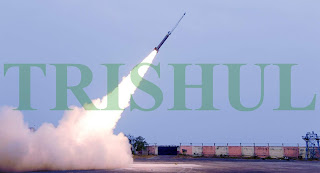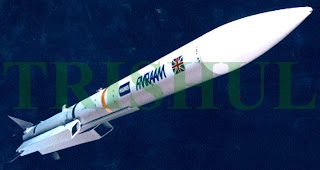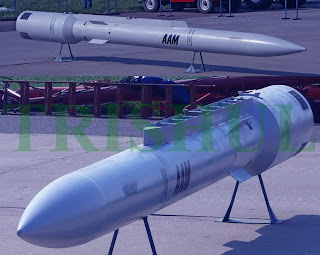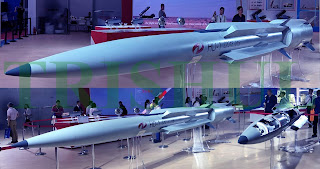The successful ground-launch and flight-testing on February 8, 2019 of a solid-fuel ducted ramjet (SFDR) as the propulsion sustainer component that has been indigenously developed by the MoD-owned Defence R & D Organisation’s (DRDO) Hyderabad-based Defence R & D Laboratory (DRDL) for a futuristic beyond-visual-range air-to-air missile (BVRAAM) meant to destroy hostile MRCAs, makes India the sixth country after the US, Russia, France, South Africa and China to have achieved success in this arena of rocket propulsion.
The DRDL-developed SFDR on the DRDO-developed BVRAAM, which is initially using the missile-body of the indigenously developed Astra Mk.1 BVRAAM, comes attached to a solid-fuel rocket booster to propel the BVRAAM to speeds at which SFDR can start operating.
The SFDR cycle is the same as the ramjet cycle except that the fuel exists in solid form within the chamber and the stoichometry of combustion is controlled by the regression rate of the fuel. The fuel is not a propellant in the solid rocket motor sense, but a pure fuel, inert without external oxidizer much like in a hybrid rocket motor. A wide range of fuels can be used from polymers such as PMMA or PE to long-chain alkanes such as paraffin or cross-linked rubbers such as HTPB. Because the fuel exists in the solid form, inclusion of solid metals is significantly easier than in a liquid-fuelled ramjet. SFDRs also offer significant advantages such as: Extremely simple compared with liquid-fuelled rockets or ramjets since, in its simplest form, a SFDR is basically a tube with a fuel grain cast in it; higher fuel density in the solid phase for pure hydrocarbons and even higher if metal additives are used; easy inclusion of metal fuels such as boron, magnesium or beryllium, which raise the heat of combustion and/or the density and therefore the density impulse capability compared with liquid ramjets; solid fuel acts as an ablative insulator, allowing higher sustained combustion chamber exit temperature levels (and hence specific thrust) with less complexity; fuel is stored within the combustion chamber, allowing for more efficient packaging and higher mass fractions than liquid ramjets; and no need for pumps, external tankage, injectors or plumbing for fuel delivery.
The earliest known SFDR Patent was filed in the US by Cordant Technologies Inc as far back as 1959. The patent can be viewed here:
While the solid-fuel booster rocket/SFDR combination has been a tried-and-tested means of propulsion, it has limitations of maximum engagement ranges against agile and manoeuvring targets like manned combat aircraft, which can bleed the energy of the BVRAAM. To improve terminal-stage manoeuvring, present-day BVRAAMs use multi-pulse solid-fuel rocket motors, with the second pulse-firing taking place only in the terminal stages after the BVRAAM’s Ka- or Ku-band active seeker has locked on to its target. The MBDA-developed Meteor BVRAAM was the first to do away with the need for multi-pulse solid-fuel rocket motors by incorporating a throttleable ducted rocket (TDR) version of a solid-fuel ramjet developed by Germany-based Bayern-Chemie. The TDR functions as an extended sustainer with variable thrust being generated by a solid propellant, but can sustain high thrust-levels for far longer periods since it acquires its oxidiser from the air. However, both BVRAAMs and LRAAMs using SFDR have a limitation: ramjet motors are heavier and take time to reach maximum speed in the initial phases, and are thus less agile. Consequently, BVRAAMs and LRAAMs using SFDRs will be less effective against agile MRCAs, but the LRAAM will be highly effective against lumbering combat-support platforms like AEW & CS aircraft and aerial refuelling tankers.
Elsewhere in the world, Russia’s Vympel JSC (now part of Tactical Missiles Corp) had by the early 1990s completed developing the SFDR-powered RVV-AE-PD BVRAAM, which hosts rear-mounted lattice-type aerodynamic control surfaces. However, this BVRAAM has not yet been series-produced.
Instead, Russia has opted for a two-stage solid-propellant rocket propulsion system for its Novator R-172S LRAAM.
In the US, Raytheon had in the 1990s developed a SFDR-equipped FRAAM variant of the AIM-120 AMRAAM. But like the RVV-AE-PD, the FMRAAM has not yet entered series-production.
Throughout the late 1970s and 1990s, Somchem of South Africa pursued R & D on SFDR-based propulsion under Project Integral, with the objective being to power both BVRAAMs and MR-SAMs (developed by KENTRON) using SFDRs. The latter, known as SAHV, was first displayed in 1995 with a rounded glass nose-section housing an IIR guidance system. To avoid over-heating of the IIR seeker during the MR-SAM’s Mach 2.3 flight to its target, the SAHV’s nose-section was fitted with a cap that was jettisoned only in the final stages of the engagement.
Making its debut at the Airshow China 2018 expo in Zhuhai last November was the HD-1, China’s first anti-ship missile using a solid-fuel ramjet combustor and a SFDR—both developed by CASC’s No.4 Institute. Developed and built by the Guangdong Hongda Mining Co, the 2,200kg HD-1’s maiden flight-test took place in October 2018. The HD-1, like the still-classified YJ-18 anti-ship missile, employs a tandem single-stage solid-propellant rocket booster—as opposed to wraparound boosters to reduce drag—for missile launch and acceleration to a forward velocity suitable for efficient operation of the ramjet’s intake system, which comprises four air-intakes arranged in an ‘X’ configuration around the missile body. Tapered control surfaces are mounted on the intake housings near the nozzles. The HD-1 has a length of 8.3 metres, with a missile body and booster diameter of 375mm and 650mm, respectively. Cruise speed is quoted as 2,716kph, while terminal cruise speed being 4,321kph, with the missile cruising at altitudes of up to 15km (49,212 feet) and performing sea-skimming manoeuvres at altitudes between 16 and 32 feet. The missile’s maximum range is 290km.
Coming back to the DRDO’s efforts to develop a BVRAAM or LRAAM using SFDR, the principal challenge remains the development of an internal data-link that will receive targetting cues from a friendly AEW & CS platform, since the AESA-MMR of the MRCA launching such an LRAAM will not be able to detect or track hostile combat-support platforms flying at distances beyond 300km. Furthermore, if the LRAAM is tasked with the destruction of hostile combat-support platforms, then the LRAAM will have a launch-weight of more than 250kg. However, if the idea is to develop a BVRAAM like the Meteor, then a maximum engagement range of 150km will suffice, while the launch-weight will have to be kept down to 220kg at most.









